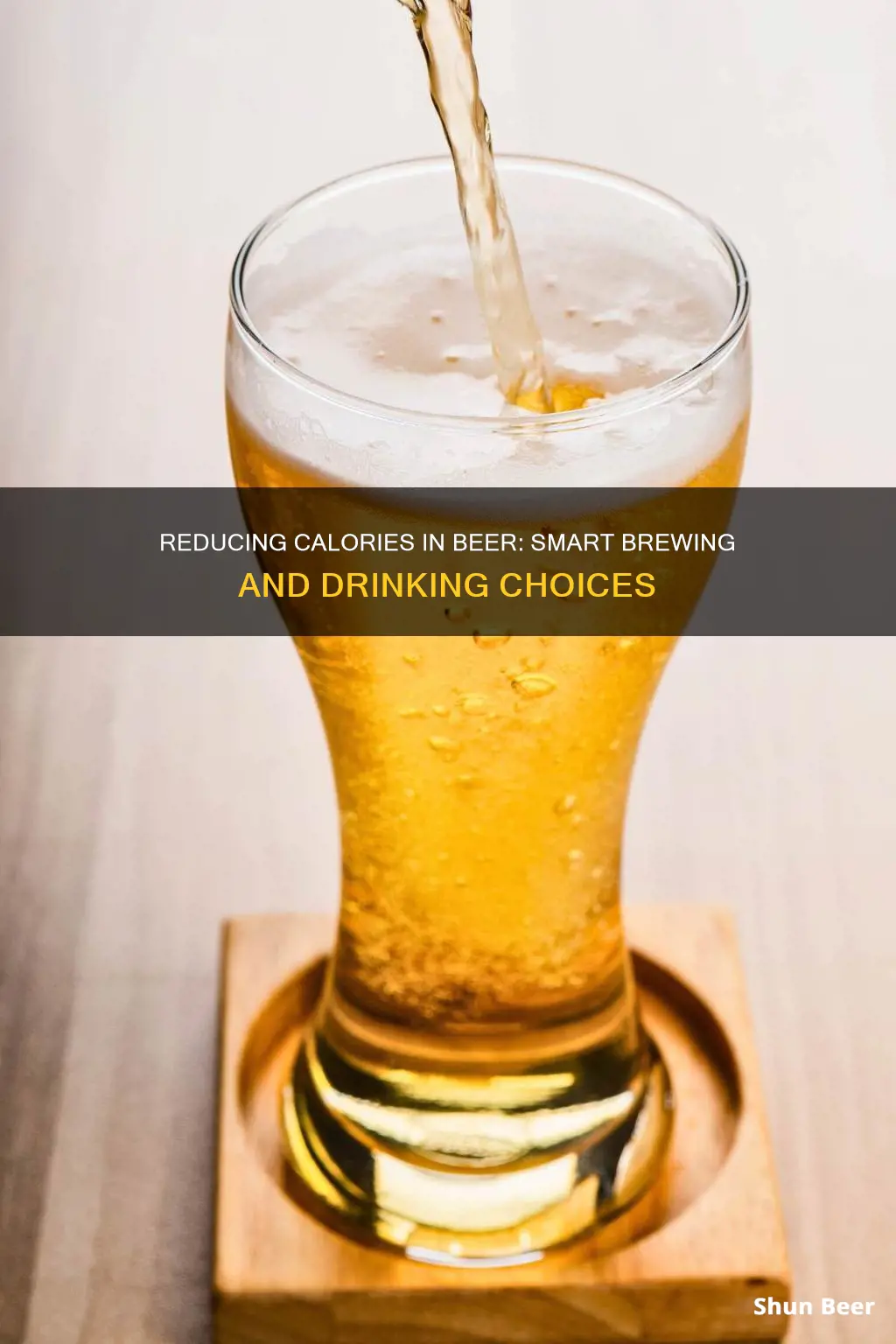
Beer is a much-loved beverage, but it can be high in calories. Most of the calories in beer come from alcohol, with residual carbohydrates from malts and grains making up the rest. This means that low-calorie beers tend to be low in alcohol and have a reduced carbohydrate count. There are several ways to reduce the calorie count in beer, including using specific ingredients, adjusting fermentation techniques, and adding supplements or enzymes.
| Characteristics | Values |
|---|---|
| Alcohol content | Lower alcohol content |
| Carbohydrates | Fewer carbohydrates |
| Ingredients | Wheat, rice, specialty grains and malts, real fruit, hops |
| Portion size | Smaller glasses or cans |
| Frequency | Less frequent consumption |
What You'll Learn

Drink light or low ABV beer
Drinking light or low-ABV beer is a great way to reduce your calorie intake. Beer is primarily composed of water, with most of the remaining calories coming from alcohol. Therefore, opting for a light beer or one with a lower alcohol content can significantly reduce the number of calories you consume.
When it comes to alcohol content, it's important to look at the percentage of alcohol by volume (% ABV). The higher the ABV, the higher the calories. So, choosing a beer with a lower ABV is a simple and effective way to cut down on calories. Beers with an ABV of less than 4.5% are generally considered low in alcohol content.
In addition to alcohol, the other major source of calories in beer is residual carbohydrates, or dextrins, from malts and grains. These dextrins are left over from the mashing process and provide body, sweetness, and calories to the beer. By reducing the amount of residual carbohydrates, brewers can create lower-calorie beers.
When selecting a light or low-ABV beer, it's important to keep in mind that these beers may have a more subtle or watered-down taste compared to their regular counterparts. This is because lowering the alcohol and carbohydrate content can also reduce the flavour and body of the beer. However, some brewers have mastered the art of creating delicious low-calorie beers by using specific ingredients and brewing techniques.
Some popular options for low-calorie beers include Budweiser Select 55, MGD 64, and Lagunitas DayTime IPA. These beers offer a refreshing and enjoyable drinking experience while helping you cut down on calories.
UK Beer Calories: How Many Are in Your Pint?
You may want to see also

Reduce portion size
Reducing your portion size is a great way to cut down on beer calories and still enjoy a cold one from time to time. Here are some tips to help you reduce your portion size:
- Opt for a smaller glass or choose a 12-ounce can instead of a 16-ounce bottle.
- Be mindful of your serving sizes, especially when eating out. Restaurant portions are often much larger than the standard serving size.
- Split snacks and meals with friends. For example, share a pizza or some nachos with a friend instead of eating a whole one by yourself.
- Ask for a to-go box and wrap up half of your meal when eating out.
- Use smaller plates at home to trick your mind into thinking you're eating more than you are.
- Drink less frequently. For example, limit your beer consumption to weekends only.
By implementing these portion control strategies, you can effectively reduce the number of beer calories you consume without completely giving up your favourite beverage.
Calories in Beer: Sleeve Count and Health Impact
You may want to see also

Drink less frequently
Drinking less frequently is one of the most effective ways to reduce your calorie intake from beer. Here are some tips to help you cut down on your drinking days:
Understand the health implications
Beer bellies, or clinically termed "abdominal obesity", are caused by the high-calorie content of alcohol. The more alcohol you consume, the higher your chances of developing this type of obesity. This type of weight gain is particularly harmful as the fat is laid down directly on and around the organs inside the abdomen, including the liver. This specific type of obesity increases your risk of heart disease, type 2 diabetes, stroke, and certain cancers.
Set realistic goals
It is important to be moderate about your drinking. The U.S. Dietary Guidelines for Americans recommend that if you choose to drink alcohol, you should limit your intake to up to 1 drink per day for women and up to 2 drinks per day for men. One drink is typically defined as 12 fluid ounces of regular beer.
Take drink-free days
Taking more drink-free days throughout the week can benefit your health and help you cut down on calories. You can try only drinking on weekends, for example. This will not only reduce your overall calorie intake but also contribute to weight loss.
Swap alcoholic drinks with non-alcoholic alternatives
Opting for non-alcoholic or low-alcohol options can significantly reduce your calorie intake. All low-alcohol drinks with 1.2% ABV or less, including alcohol-free options, are required by law to display nutritional information, including calories, on the label. This makes it easier for you to make informed choices.
Don't drink the night before exercising
Drinking the night before a planned exercise session can hinder your performance. Having a night off from drinking could improve your fitness performance and ensure you stay on track with your health and fitness goals.
Track your drinking and calories
Consider using a mobile application to track and monitor your drinking habits and calorie intake. There are various apps available, such as the MyDrinkaware app, which can help you set goals and reduce your alcohol and calorie consumption.
Calories in Grolsch Beer: How Many Are There?
You may want to see also

Choose lower-carb beers
If you're looking to reduce your calorie intake from beer, choosing a lower-carb option is a good strategy. Carbohydrates are a significant source of calories in beer, so opting for beers with fewer carbs can help cut down on calories. Here are some tips to choose lower-carb beers:
- Check the Carbohydrate Content: Before purchasing, check the nutritional information on the beer label or the brewer's website. Look for beers that have a lower carbohydrate content. The number of grams of carbohydrates per serving or per 12 ounces (355 millilitres) can be a good indicator. Typically, commercial beers considered low-carb will have fewer than 5 grams of carbs per serving.
- Opt for Lighter Beers: Lighter beers tend to have fewer carbohydrates. Look for terms like "light" or "lite" on the packaging or in the beer's name. These beers often have a lower alcohol content, which also contributes to a reduced calorie count.
- Choose Dry Beers: Dry beers tend to have fewer residual sugars and, as a result, lower carbohydrate content. Look for descriptions such as "brut" or "dry-hopped" to indicate a lower-carb option.
- Consider Low-Carb Alternatives: Some breweries specifically market their beers as low-carb options. For example, Michelob Ultra, Budweiser Select 55, and Corona Premier are known for their lower carbohydrate content.
- Check Online Resources: There are websites and apps dedicated to providing nutritional information for different beers, including their carbohydrate and calorie content. Utilize these resources to help you make an informed decision when choosing a lower-carb beer.
- Homebrewing Options: If you're a homebrewer, you can experiment with different techniques to reduce the carb content in your beer. This may include using ingredients that contribute flavour without increasing carbs, such as specialty grains, real fruit, or carefully selected hops. Additionally, you can use enzymes like Beano or Amylo 300 during the brewing process to break down complex carbohydrates.
Remember, when choosing a lower-carb beer, it's important to consider your taste preferences as well. Reducing carbohydrates may result in a lighter flavour or a different mouthfeel. However, with the wide variety of beers available today, you can certainly find lower-carb options that still suit your taste buds.
Calories in Innis & Gunn Beer: Nutritional Breakdown
You may want to see also

Brew your own low-calorie beer
Creating your own low-calorie beer at home can be a fun and rewarding experience, especially if you're looking to cut down on carbs or calories. Here are some tips and techniques to help you get started:
Choose the Right Ingredients
Select ingredients that will impart flavour without increasing the calorie content. This might include specialty grains and malts, real fruit, and carefully chosen hops. For example, you can use grains like wheat and rice, which can result in a lighter beer. Fruit purées can also be added to provide flavour without adding too many carbohydrates or calories.
Manage Your Mash
The mashing process involves adding hot water to the grain at specific temperatures to encourage enzymes to break down starch into smaller, fermentable sugars. Managing your mash carefully can help maximize the production of fermentable sugars and minimize the formation of dextrins, which are non-fermentable and contribute to the calorie count. One technique is to start mashing at a temperature of 149°F (65°C), which is the overlapping temperature for alpha and beta amylase enzymes, and then drop the temperature to the beta range to help maximize the fermentable extract.
Use Enzymes
Enzymes such as amyloglucosidase (AMG) or Amylo 300 can be added during the mashing or fermentation process to break down dextrins or complex carbohydrates, resulting in a lower calorie beer. Beano, a dietary supplement, can also be used to break down complex carbohydrates, but it may increase the alcohol content.
Choose the Right Yeast
Selecting the right yeast is important for low-calorie brewing. Look for a high-attenuating yeast that can ferment a large amount of sugar and tolerate higher alcohol contents. Some yeasts, such as English Ale yeast, can also provide more body to your beer while keeping the calories relatively low.
Adjust the Hop Schedule
As you reduce the alcohol and body of the beer, you may need to adjust the hop schedule to maintain the proper balance of flavours. Reducing the bitterness of the hops can help compensate for the lower alcohol and body, resulting in a more balanced and enjoyable beer.
Final Thoughts
Brewing your own low-calorie beer allows you to be creative and experiment with different ingredients and techniques. Remember that the key to a successful low-calorie beer is balancing flavour and body while reducing calories. With some trial and error, you can create a delicious and refreshing beer that fits your taste preferences and dietary needs.
Calorie Count of Rebel IPA Beer: Everything You Need to Know
You may want to see also
Frequently asked questions
The easiest way to reduce calories in beer is to reduce the alcohol content, as alcohol is a pretty high-calorie content. However, this will also reduce the flavour of the beer.
Other ways to reduce calories include cutting down on residual carbohydrates, which are left over after the fermentation process. This can be done by adding enzymes such as Amylo 300 or Beano to the beer, which break down complex carbohydrates.
Some low-calorie beers include Budweiser Select 55, MGD 64, Milwaukee's Best Light, and Yuengling Light Lager 99.
To improve the taste of low-calorie beer, you can add hops for bitterness and balance, or spices for a warming effect. Fruit additions can also bring a lot of flavour to lighter beers, but fruit juices and purees contain a lot of calories.







